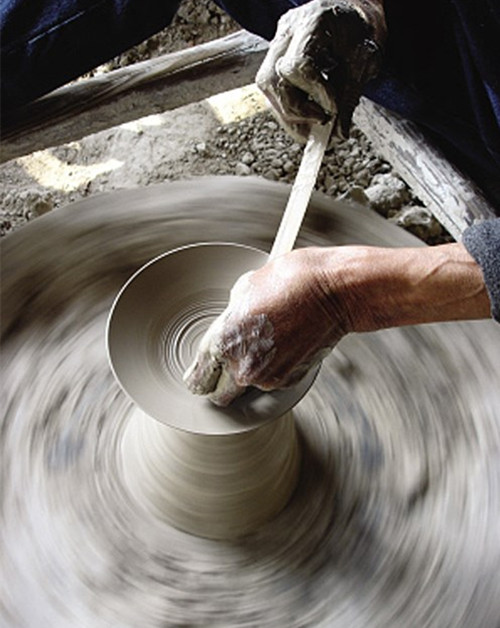 |
|
Local people is making a porcelain.[315che.com]
|
A Porcelain Hub
Porcelain once occupied an important place in Wanyao Village. A variety of porcelain wares displayed in the village’s museum keep a record of the past.
The ancestors of Wanyao residents hailed from Lianjiang of Fujian Province. Fleeing from battles, they migrated towards Zhejiang, enduring much hardship on the way. Attracted by the natural environment of Wanyao Village, they finally settled down. The settlers cultivated the untilled land and constructed houses and kilns. Some of them were already skilled in firing porcelain and began to take advantage of the natural resources, using water as power, hay as fuel and kaolin clay as the raw material to revive the ancient technique of porcelain production. While surrounding villages and towns were still in the early stages of establishing an agricultural economy, Wanyao Village had shaped a society with specific divisions of labor and a booming porcelain industry. The village developed into a well-known porcelain-trading center during the reign of Emperor Kangxi (1661-1722) and Emperor Qianlong (1735-1796) in the Qing Dynasty (1644-1911).
As industry thrived, more and more people were attracted to the village, which at one time had over 4,000 residents. Products varied from big and small bowls to cups and spoons, catering to people’s needs in daily life. In addition to the counties in Wenzhou, the products were also sold in Jiangsu, Anhui, Shandong, and Taiwan, to name a few. In the golden age, numerous workshops, 40 water-powered trip hammers and 18 dragon kilns worked day and night.
An Uncertain Future
Today, advanced techniques have replaced the conventional skills of porcelain making. Kilns fueled by coal, electricity and gas make mass and fast production possible. The dragon kiln in the village has been shut down for years and hand-made bowls are rare in the market – but the memory of them remains clear. The busy porcelain hub is once again a quiet village in which less than 100 residents live, the majority of them senior citizens.
The local tourism bureau is striving to preserve the village’s tradition. Yu Zhenman, a potter in his 60s, is part of one such preservation initiative. Yu had worked in a porcelain factory in the village for over 40 years. When the factory closed down, he chose to stay in the village. Now, he demonstrates traditional porcelain making for visitors.
I watched Yu’s performance next to a dragon kiln. Taupe pottery clay had already been crushed by a water-powered trip hammer and mixed thoroughly. Yu then dug out a lump of clay with his hands and put it on a pottery wheel. While rotating the turntable, Yu gently and swiftly pressed, squeezed and pulled the clay upwards and outwards. Magically, a bowl was shaped in his hands, like a flower coming into bloom. Yu told me that he used to make 1,000 bowls of this kind in a day when he worked in the factory. The margin of error of each bowl was limited to one millimeter. He could make more than 100 kinds of wares such as mugs and oil lamps, and as we were talking, he whipped up a small wine cup.
Yu encouraged me to make my own bowl. I sat down and followed his instructions. However, I could not work the clay in my hands into anything like a bowl. Yu comforted me, saying: “I have been doing this for decades. But it is your first time.” He also told me that rustic hand-made bowls were well received among tourists. “It can be considered a souvenir from Wanyao Village,” Yu said.
Yu likes this job. He is happy to perform for tourists but hopes more and more people will visit in the future. On quiet days, he relies on farm work to earn a living. Working the land, he often comes across kaolin clay. It’s an exciting find for him, but what can he actually do with his treasure?
The kiln fire has long died down and Yu’s deft hands can no longer earn him a decent wage – he gets just RMB 300 a month for his pottery show. While the younger generations migrate to bigger cities for work, seniors are left in the village to do simple farm work to make ends meet. Their life in this remote village is not easy – they have to go a long way for daily necessities.
We Recommend:
